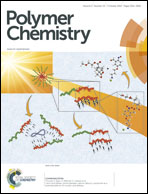Oligo(p-phenyleneethynylene) embedded amphiphiles: synthesis, photophysical properties and self-assembled nanoparticles with high structural stability and photostability for cell imaging
Abstract
Novel amphiphilic organic asymmetrically oligo(p-phenyleneethynylene) (OPE) conjugated molecules, ending with a hydrophobic alkyl chain and a hydrophilic methoxypolyethyleneglycol (MPEG) segment, were designed and synthesized. Due to the hydrophilic–hydrophobic nature of the asymmetrically amphiphilic OPE conjugated molecules, monodispersed fluorescent nanoparticles were obtained easily by self-assembly in aqueous solution. Through adjusting the length of MPEG chains in amphiphilic OPE, a series of nanoparticles with different water solubility were prepared. The aggregation behaviors of these dyes were investigated by dynamic light scattering (DLS) and transmission electron microscopy (TEM), which indicated that when the MPEG chains bonding with amphiphilic OPE are longer, smaller sized nanoparticles will be formed at the same concentration of 10−5 mol L−1. Besides, taking OPE–PEG1900 as an example, diversified aggregation behaviors under different concentrations can be inferred through DLS and TEM, which were also supported by ultraviolet absorption (UV) and photoluminescence (PL) analyses. Compared with previously reported conjugated-polymer nanoparticles consisting of amphiphiles without photoelectric features and oil-soluble conjugated-polymers through non-covalent encapsulation, the introduction of OPE chromophores into amphiphiles by covalent linkage efficiently enhanced the structural stability of nanoparticles. A photobleaching test under UV excitation revealed the high photostability of these OPE nanoparticles. In view of the good water solubility, biocompatibility, structural stability, photostability, and excellent photoelectric features of these nanoparticles, cellular imaging of human pancreatic cancer cells (PANC-1 cells) was conducted. Confocal microscopy results showed that the nanoparticles (OPE–PEG1000 and OPE–PEG1900) were located specifically within the cell cytoplasm. We believe that the OPE nanoparticles would play an important role as fluorescent biomarkers for long-term bioimaging, and offer new opportunities for good applicability in cell imaging and sensing in biomedical science.


 Please wait while we load your content...
Please wait while we load your content...